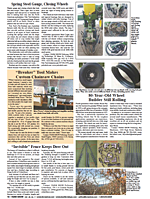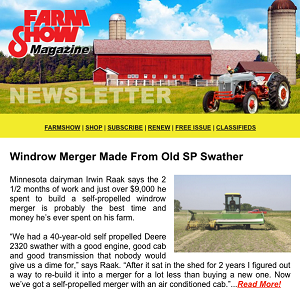Google Earth Farm Planner
 ✖  |
Steve Gabriel uses Google Earth to identify the location of each maple tree he plans to tap. By adding a terrain layer, he can see how to lay out tubing for the gravity vacuum flow of sap to collection points. He also uses it to plan his grazing rotation, cropping and drainage patterns. He even uses it to gain nearly 30 years of historical perspective on his farm.
“Once you find an image of your farm, you can look back at images gathered every few years back to 1995,” says Gabriel.
Gabriel doesn’t just use Google Earth on Wellspring Forest Farm, his own farming operation. As an extension educator with the Cornell Small Farms Program, he taught others how to use it. His 2019 four-part YouTube series on Google Earth for Farmers thoroughly introduces the software and how to use it on your farm.
Farm planning has come a long way since the days of jotting planting dates in a seed company notebook. Gabriel and Google Earth take it even farther. While there are many YouTube videos on the subject, Gabriel’s are focused, with a complete step-by-step approach that includes how to overlay the original map with new layers, insert data, save layers, and access them in the future for endlessly customized aerial views. Finally, he covers importing entire data sets, such as soil and environmental data, to add great depth to planning.
He begins part one by opening the software and displaying his farm. He then walks through basic geographic information data (GIS), starting with latitude, longitude and elevation. He then explains how to view the aerial image from different perspectives and access data sets in the software. These include tax parcel information, terrain and the historical information mentioned above.
In part two, he moves on to inserting points, lines and polygons (shapes of all types), including distances from one point to another and areas inside a shape. Once a point, line or area has been defined, it can be labeled with information added in a notes field. When that layer is brought up in the future, additional information can be added, such as planting dates, harvest data or dates pasture paddocks were rotated and the number of animals.
“The measurement tool is phenomenal for designing and planning on the farm,” says Gabriel. “Use a line to plan a fence or a polygon to plan the perimeter and area of a paddock. Save the layer and then return later and change the shape as plans change.”
As he covers the basics of outlining fields and other landscape features, he repeatedly emphasizes the importance of saving and organizing the layers in folders for future access.
“You can never save your work enough,” says Gabriel. “Periodically, save your layers to their folders. If not, and the program crashes, you lose anything unsaved.”
In part three, Gabriel demonstrates how to create property boundaries using temporary overlays of a survey map. He describes browsing the web for maps, identifying suitable types, downloading them to a desktop, and opening them in Google Earth.
A custom topographical map can be created using one of the online contour-generating programs. Instead of the standard 20-ft. intervals of a typical contour map, set intervals to only a few feet to identify swales, dig new ones, or create catchment basins.
Locating and accessing data sets like SoilWeb requires a similar approach. An interactive map created at the University of California, Davis, is based on the USDA-NCSS soil survey. Gabriel recommends it as easier to work with than the NRCS version. This is just the beginning of what’s available.
“You can go to your browser and find water data from the EPA or check for data from your state government,” he says. “Just look for file extensions of .kml, .mkx or .shp. Google Earth accepts all three.”
In part four, Gabriel walks the viewer through several software applications for his farming operation. He demonstrates planning and mapping field roads and paths. He also shares mapping woods he leases for maple syrup production, including tree locations and collection points. As in the earlier parts of the series, Gabriel’s examples bring home the potential value of Google Earth for farmers.
Contact: FARM SHOW Followup, Steve Gabriel (stevegabrielfarmer@gmail.com; www.WellspringForestFarm.com; YouTube: @farmingwithtrees).

Click here to download page story appeared in.
Click here to read entire issue
Google Earth Farm Planner Steve Gabriel uses Google Earth to identify the location of each maple tree he plans to tap By adding a terrain layer he can see how to lay out tubing for the gravity vacuum flow of sap to collection points He also uses it to plan his grazing rotation cropping and drainage patterns He even uses it to gain nearly 30 years of historical perspective on his farm “Once you find an image of your farm you can look back at images gathered every few years back to 1995 ” says Gabriel Gabriel doesn’t just use Google Earth on Wellspring Forest Farm his own farming operation As an extension educator with the Cornell Small Farms Program he taught others how to use it His 2019 four-part YouTube series on Google Earth for Farmers thoroughly introduces the software and how to use it on your farm Farm planning has come a long way since the days of jotting planting dates in a seed company notebook Gabriel and Google Earth take it even farther While there are many YouTube videos on the subject Gabriel’s are focused with a complete step-by-step approach that includes how to overlay the original map with new layers insert data save layers and access them in the future for endlessly customized aerial views Finally he covers importing entire data sets such as soil and environmental data to add great depth to planning He begins part one by opening the software and displaying his farm He then walks through basic geographic information data GIS starting with latitude longitude and elevation He then explains how to view the aerial image from different perspectives and access data sets in the software These include tax parcel information terrain and the historical information mentioned above In part two he moves on to inserting points lines and polygons shapes of all types including distances from one point to another and areas inside a shape Once a point line or area has been defined it can be labeled with information added in a notes field When that layer is brought up in the future additional information can be added such as planting dates harvest data or dates pasture paddocks were rotated and the number of animals “The measurement tool is phenomenal for designing and planning on the farm ” says Gabriel “Use a line to plan a fence or a polygon to plan the perimeter and area of a paddock Save the layer and then return later and change the shape as plans change ” As he covers the basics of outlining fields and other landscape features he repeatedly emphasizes the importance of saving and organizing the layers in folders for future access “You can never save your work enough ” says Gabriel “Periodically save your layers to their folders If not and the program crashes you lose anything unsaved ” In part three Gabriel demonstrates how to create property boundaries using temporary overlays of a survey map He describes browsing the web for maps identifying suitable types downloading them to a desktop and opening them in Google Earth A custom topographical map can be created using one of the online contour-generating programs Instead of the standard 20-ft intervals of a typical contour map set intervals to only a few feet to identify swales dig new ones or create catchment basins Locating and accessing data sets like SoilWeb requires a similar approach An interactive map created at the University of California Davis is based on the USDA-NCSS soil survey Gabriel recommends it as easier to work with than the NRCS version This is just the beginning of what’s available “You can go to your browser and find water data from the EPA or check for data from your state government ” he says “Just look for file extensions of kml mkx or shp Google Earth accepts all three ” In part four Gabriel walks the viewer through several software applications for his farming operation He demonstrates planning and mapping field roads and paths He also shares mapping woods he leases for maple syrup production including tree locations and collection points As in the earlier parts of the series Gabriel’s examples bring home the potential value of Google Earth for farmers Contact: FARM SHOW Followup Steve Gabriel stevegabrielfarmer@gmail com; www WellspringForestFarm com; YouTube: @farmingwithtrees
To read the rest of this story, download this issue below or click
here to register with your account number.







